Can you eat well in Ireland? Yes, I can assure you from my own experience that you can eat very tasty food in Ireland, especially in Dublin…
Page Contents (click line to jump the text)

Intro
In the past, when Ireland was still one of the poorer countries in Europe, food had to be cheap and filling. The staple foods of the time, potatoes, carrots and cabbage, can still be found in many traditional Irish dishes today. But meat, fish and seafood are also traditionally included in typical Irish dishes – and often of the very best quality!
Today we are many years further on, Ireland has developed into an economic success story and more and more travellers are discovering the Emerald Isle – and its cuisine – every year.
The island has opened up to culinary influences from around the world and while traditional Irish cuisine is being preserved, there is more and more fine dining, more ingredients from around the world and more different styles of cookery enriching the food in Ireland.
In Dublin in particular, you’ll find a rich variety of wonderful Irish dishes – traditional or modern interpretations.
I know Dublin quite well because we live just south of the city. Although my family and I are from Germany, we have been living here for several years (as a second home). Personally, I really like Irish cuisine.
But what are typical Irish dishes? We’ll get to that now:
Typical Irish dishes
I’ll keep this section short, because I’ve already written a separate article on the subject of “Irish dishes”, which I’ll link to at the bottom of the text.
Here I’ll just list a few typical dishes that you should try (or a few of them :-)):
Soups, stews and starters
Colcannon Soup: This soup is based on the traditional Irish dish colcannon, which consists of potatoes, cabbage and sometimes leeks – this time as a soup.
Irish Stew: A savoury stew of lamb, potatoes, carrots and onions. It is traditionally slow-cooked and is particularly popular on cold days.
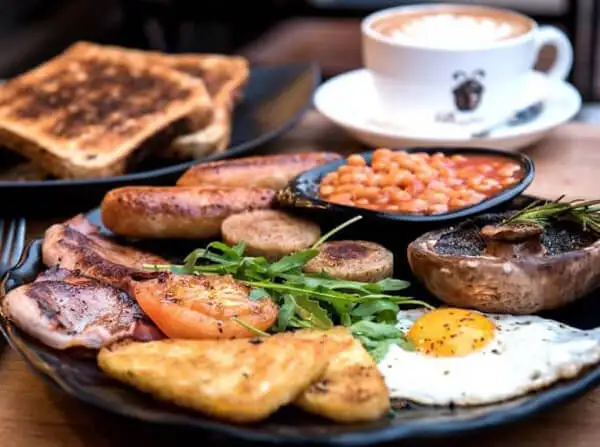
Coddle: A hearty stew with sausages, bacon, onions and potatoes. It is a dish that is often referred to as “poor man’s food” but is nevertheless delicious.
Guinness Beef Stew: Another stew made with Guinness beer and containing tender beef, carrots and potatoes. The flavour of the beer gives this dish a special touch.
Seafood Chowder: As Dublin is located on the coast, seafood chowder is a delicious option. This creamy soup consists of a variety of seafood, potatoes and cream.
Soda Bread: A traditional Irish bread made with baking soda as a leavening agent. It is usually served with soups and stews.
Main courses with fish and seafood
Fish and chips: The classic, breaded fried fish with chips. Often served with mixed vegetables in restaurants.
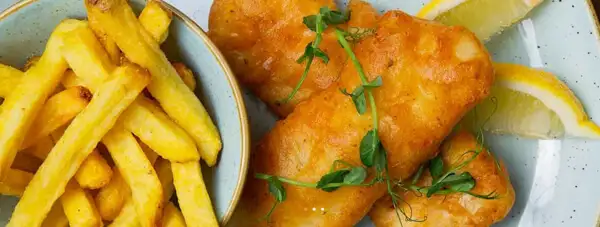
Salmon, cod or hake fillet: Salmon is salmon, cod is cod and hake is hake. All are fished in Irish waters and are served fresh, often with mash and mixed vegetables. Mash is roughly equivalent to mashed potato or a slightly coarser mashed potato.
Dublin Bay Prawns (Dublin king prawns): These king prawns are very popular in Dublin and are often served grilled or steamed. Their flavour is very delicate.
Dublin Lawyer: This is a special preparation of lobster cooked in a sauce of butter, whiskey and cream. It is a delicacy in Dublin.
Main courses with meat
Irish Beef Steak: An international dish, but in Ireland the beef is usually of excellent quality! It is often served with split potatoes and vegetables.
Boxty: A type of potato pancake made from grated potatoes and flour. It is available in different variations, filled with meat or as a side dish to other dishes. If you come from a German-speaking country or the Alpine region, you may feel more reminded of potato rösti or potato pancakes than pancakes.
Irish Breakfast: A sumptuous hot breakfast with sausages, bacon, black pudding (fried black pudding), white pudding (fried liver sausage), fried tomatoes, mushrooms, eggs and toast. It’s a classic Irish breakfast that will energise you for the day. It’s a very large portion, which is why it’s often eaten for lunch.
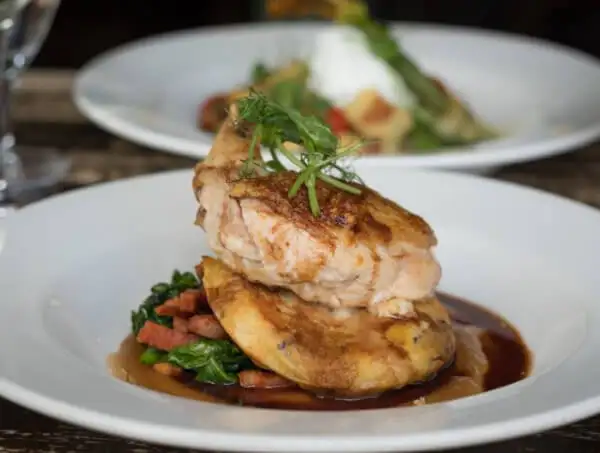
Bacon and Cabbage: Pork (similar to Canadian bacon) is served with cabbage, often with potatoes or a light, creamy sauce.
Irish Roast Beef: slices of roast beef with gravy, often served with Yorkshire pudding (a type of puff pastry), mash (mashed potatoes) and peas.
Bangers and Mash: Bangers are thin sausages and mash is mashed potato. They are served with fried onion rings and a dark gravy.
Chicken Goujons: These are breaded fillet pieces of chicken with any ingredients, such as peas, mixed vegetables and chips or potatoes.
Desserts, baked goods and confectionery
Cheesecake: Cheesecake comes in different varieties, sometimes very creamy and sometimes firmer in consistency. Often with ice cream, whipped cream or fruit.
Apple crumble: A traditional dessert made from apples baked with crumbles of butter, flour and sugar. It is often served with a scoop of vanilla ice cream.
Chocolate cake: Very good chocolate cake with cream or a scoop of Valille ice cream.
Death by Chocolate: Warm chocolate cake with a liquid centre and liquid topping and a scoop of ice cream. Very tasty and very intense!
Irish pancakes: These thin, fluffy pancakes are often served with lemon juice and sugar, maple syrup or fruit jam.
Irish trifle: A layered dessert made from fruit, sponge cake, custard and cream, often flavoured with a shot of Irish whiskey.
Irish scones: These pastries can be eaten for breakfast, dessert or with tea or coffee. The scones are usually served with butter, jam or clotted cream.

Restaurant tips in Dublin
Irish pubs often also have a restaurant where you can usually enjoy typical Irish food. If you are travelling in the countryside, there are often no restaurants at all, only pubs in the smaller towns.
There is a lot of choice in Dublin. Here I have listed a few restaurants in Dublin where you can definitely enjoy Irish cuisine:
MV Cill Airne: This restaurant is located on a restored river steamer from the 1960s. It offers elegant surroundings and beautiful views of the River Liffey. Here you can enjoy fine cuisine and experience the atmosphere of the river at the same time. Some of the dishes are Irish. See: https://www.mvcillairne.com/.
The Woollen Mills: This restaurant is located on Ormond Qay, so also on the water. It is known for its more modern and refined interpretation of classic Irish dishes. See: https://www.thewoollenmills.com/.
The Winding Stair: This is a sister restaurant to Woollen Mills. It is also on the river, near the Ha`Penny Bridge. Very good modern Irish food, also very good dishes from the sea. See: https://www.winding-stair.com/.
The Church: This restaurant in the northern city centre has a special atmosphere because it is housed in an 18th century church. Wide selection of Irish dishes. There is also Irish live music and Irish dancing. See: https://www.thechurch.ie/.
FX Buckley Steakhouse: Best steaks, Irish interpretations and Irish meat dishes. There are two locations in Dublin. See: https://www.thebuckleycollection.ie/crow-street.
Gallagher’s Boxty House: This restaurant in Temple Bar is dedicated to the Irish boxty. Here you can try different variations of this traditional Irish dish. See: https://www.boxtyhouse.ie/.
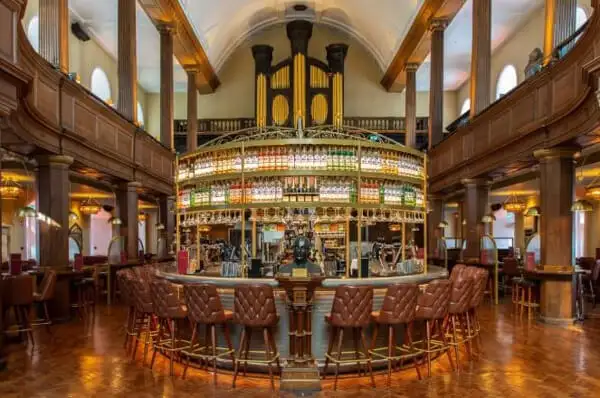
The Fish Shop: When it comes to fish and seafood, this small restaurant is a good choice. See: https://fish-shop.ie/.
Etto: Fine dining, small plates, Irish and international dishes. See: https://www.etto.ie/.
This gives you a starting point for your search for good restaurants with Irish cuisine.
Guided Culinary Tours in Dublin
You can of course also join a guided culinary tour, such as this one:
Irish Food Trail: Guided, approximately three-hour, city walk with stops at good Irish restaurants. See: https://irishfoodtrail.ie/irish-food-trail-experience-dublin/.
Walking Food Tours Dublin: Food on Foot Walking Tour through Dublin. Good, down-to-earth food and street food. See: https://walkingfoodtours.ie/food-on-foot/.
Delicious Dublin Tours: Three-hour guided walking tour with 5 stops and tastings at very good restaurants and food shops. See: https://deliciousdublintours.com/food-tours/.
Secret Food Tours: Comparable food walk over 3-4 hours with several stops to sample Irish dishes. See: https://www.secretfoodtours.com/dublin/food-tours-dublin.
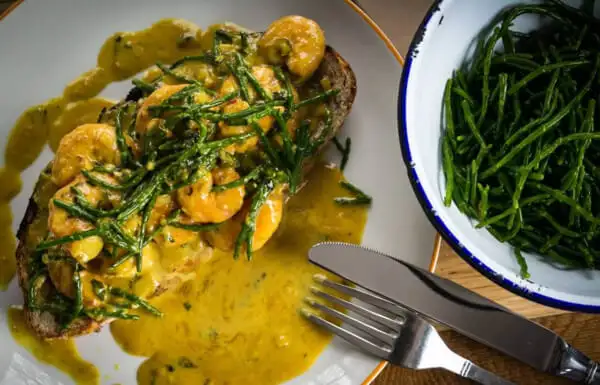
Food Festivals
If you’re lucky, a food festival will be taking place during your visit to Dublin. I have a few examples for you here:
Taste of Dublin: An annual festival that brings together the city’s best restaurants and chefs. See: https://tasteofdublin.ie/.
Dublin Bay Prawn Festival: This festival in May celebrates Dublin’s king prawns with live cooking demonstrations, tastings, music and entertainment. The current programme is probably not yet available – just keep googling. See: https://dublin.ie/whats-on/listings/dublin-bay-prawn-festival/.
Dublin VegFest: For all vegans and those interested in a plant-based diet, this festival offers a wide range of vegan food, workshops and talks. The new programme is still missing. See: https://dublinvegfest.com/.
The Big Grill: A festival for barbecue lovers, offering a selection of grilled food, BBQ competitions, workshops and live music. See: https://www.biggrillfestival.com/.
Dublin Coffee & Tea Festival: For coffee lovers and tea drinkers, this is a fairly new festival in March. See: https://www.dublincoffeefest.com/.
Conclusion
The Irish cherish their traditions and therefore also the traditional Irish dishes. But in Dublin you will also find modern variations and international cuisine.
Whether you prefer meat dishes, fish and seafood, or pastries and sweets, you will find a wide selection to suit every taste in Dublin.
Take a food tour, visit a restaurant on a boat or on the riverbank, nibble your way through numerous coffee shops or teashops – and enjoy Dublin in all its facets and flavours.
Have fun in Dublin – and bon appétit!
More interesting articles for you
DUBLIN`S LIQUID GOLD: DISTILLERY TOURS AND BREWERY EXPERIENCES
LIFE MUSIC IN DUBLIN – THESE ARE THE PUBS TO GO!
FESTIVALS IN DUBLIN – PARTY LIKE THE IRISH!
WHERE TO STAY IN DUBLIN – OPTIONS AND TIPS
Image credit: Photo by Patrick Browne on Unsplash